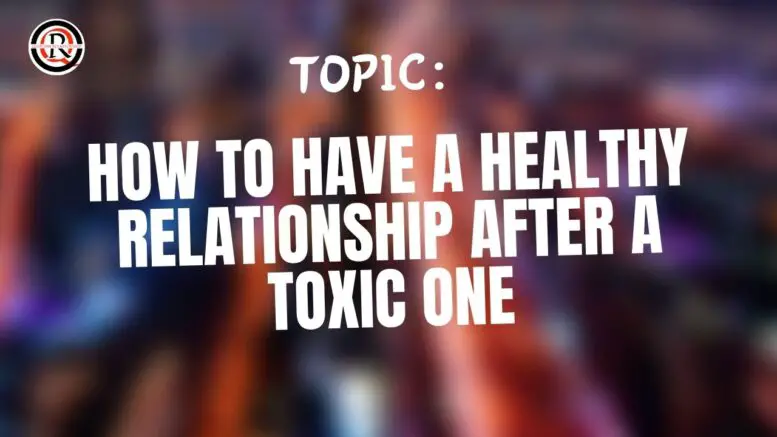Transitioning into a healthy relationship after A toxic one is a journey fraught with challenges and self-discovery. Emerging from the shadows of toxicity requires courage, resilience, and a commitment to personal growth. However, embarking on this journey opens doors to healing, self-love, and the possibility of nurturing fulfilling connections. In this exploration, we will go into the transformative process of rebuilding and fostering healthy relationships after enduring the tumult of toxicity.
The aftermath of a toxic relationship can leave deep emotional scars, affecting one’s sense of self-worth, trust in others, and belief in the possibility of love. Whether it was characterized by emotional manipulation, control, or abuse, the remnants of toxicity linger long after the relationship ends. Yet, amidst the pain and wreckage, lies the potential for renewal and redemption.
Understanding the hallmarks of a healthy relationship is crucial in navigating the path forward. Mutual respect, open communication, trust, and genuine care form the bedrock of healthy connections. Unlike the turbulent dynamics of toxicity, healthy relationships foster a sense of safety, support, and emotional intimacy.
However, the transition from toxicity to healthiness is not linear or easy. It requires introspection, self-awareness, and a willingness to confront past traumas. Healing from the wounds inflicted by a toxic partner demands patience and self-compassion. It involves unraveling ingrained patterns of behavior, challenging distorted beliefs, and reclaiming autonomy.
Moreover, establishing healthy boundaries becomes paramount in safeguarding one’s emotional well-being. Learning to recognize and assert boundaries is a pivotal step in cultivating relationships grounded in mutual respect and understanding. It empowers individuals to prioritize their needs, values, and boundaries, fostering a sense of empowerment and agency.
Yet, the journey towards healthy relationships extends beyond individual healing. It involves cultivating empathy, compassion, and vulnerability in fostering meaningful connections with others. It requires a willingness to embrace vulnerability, authenticity, and forgiveness, both towards oneself and potential partners.
In essence, the pursuit of healthy relationships after enduring toxicity is a testament to resilience and the capacity for growth. It signifies a commitment to self-love, self-respect, and the belief that one deserves happiness and fulfillment. While the road may be fraught with challenges and setbacks, the destination offers the promise of genuine connection, intimacy, and emotional fulfillment. Through self-reflection, healing, and a dedication to personal growth, individuals can transcend the shadows of toxicity and embrace the radiant possibilities of healthy, nurturing relationships.
What Is Really A Toxic Relationship?
A toxic relationship is one that is characterized by behaviors, dynamics, and interactions that are harmful, detrimental, or emotionally damaging to one or both partners involved. These relationships often lack mutual respect, trust, and communication, leading to a cycle of negativity and distress.
Here are some common signs and characteristics of a toxic relationship:
1. Lack of Communication: Communication breakdowns, constant misunderstandings, and difficulty expressing thoughts and feelings openly can create tension and resentment in the relationship.
2. Control and Manipulation: One partner may try to control or manipulate the other’s thoughts, behaviors, or decisions. This can manifest as emotional manipulation, gaslighting, or exerting power and dominance over the other person.
3. Jealousy and Possessiveness: Excessive jealousy, possessiveness, and insecurity can lead to controlling behaviors, accusations, and attempts to isolate the partner from friends, family, or other social connections.
4. Constant Criticism: Partners in toxic relationships may frequently criticize, belittle, or demean each other. This constant negativity erodes self-esteem and leads to feelings of worthlessness or inadequacy.
5. Lack of Boundaries: Boundaries are often disregarded or violated in toxic relationships. One partner may overstep personal boundaries, invade privacy, or disrespect the other’s autonomy and independence.
6. Dishonesty and Betrayal: Lies, deceit, and betrayal erode trust and undermine the foundation of the relationship. Infidelity, secrets, or ongoing deception can cause irreparable damage to the partnership.
7. Unresolved Conflicts: Instead of resolving conflicts in a healthy and constructive manner, toxic relationships may involve escalating arguments, blame-shifting, or avoidance of issues altogether. This leads to unresolved tensions and ongoing resentment.
8. Emotional or Physical Abuse: Toxic relationships may involve various forms of abuse, including emotional, verbal, psychological, or physical abuse. These behaviors are intended to exert control, instill fear, and maintain power over the other person.
9. Cycle of Drama: The relationship may be characterized by a constant cycle of drama, chaos, and instability. This can include frequent breakups and makeups, intense arguments, and volatile emotions.
10. Feeling Drained or Exhausted: Being in a toxic relationship often leaves individuals feeling emotionally drained, exhausted, and unhappy. Despite efforts to improve the situation, the toxicity persists, taking a toll on mental and emotional well-being.
It’s essential to recognize these signs and seek support if you’re in a toxic relationship. Whether through therapy, counseling, or seeking guidance from trusted friends and family, it’s possible to break free from toxic patterns and cultivate healthier, more fulfilling relationships.
How To Have A Healthy Relationship After A Toxic One
There are several crucial aspects to maintaining a healthy relationship after a toxic one. A robust intimate life and trust are among them. Additionally, effective communication, shared domestic responsibilities, common interests, individual pursuits, and financial transparency are vital components of a thriving relationship.
Yet, one aspect often overlooked is the necessity of fun. Amidst the daily responsibilities of work and bills, the joy of shared laughter can fade. However, it’s essential to remember that no relationship can flourish in a solely serious atmosphere.
If you find your relationship lacking excitement, it’s imperative to take action promptly. Rather than overanalyzing, focus on introducing enjoyable activities into your routine starting today.
- Spontaneous Adventures:
Taking impromptu trips allows couples to break away from their daily routines and experience new environments together. Whether it’s a beach trip, a late-night casino visit, or a picnic in the hills, these adventures create shared memories and excitement.
- Home Entertaining:
Hosting house parties offers a budget-friendly way to have fun without leaving the comfort of home. By organizing the ambiance, food, music, and guest list, couples can tailor the experience to their preferences and enjoy quality time with friends and loved ones.
- Playful Intimacy:
Adding spontaneity and playfulness to intimacy can reignite the passion in a relationship. Experimenting with items like chocolate body spread, flavored condoms, and intimate games can enhance the physical connection and bring joy to the bedroom.
- Thrilling Pursuits:
Engaging in extreme sports together provides an adrenaline rush and strengthens the bond between partners. Activities like skydiving, rock climbing, and bungee jumping offer thrilling experiences and create lasting memories.
- Role-Play Dates:
Participating in fake dating scenarios adds an element of excitement and novelty to date nights. Couples can pretend to be strangers meeting at a bar, enjoying the reactions of those around them and sharing laughs as the evening unfolds.
- Educational Endeavors:
Exploring new interests through classes or workshops fosters personal growth and strengthens the relationship. Whether it’s learning art, cooking, languages, or martial arts together, couples bond over shared experiences and mutual support.
- Game Nights:
Hosting game nights provides a fun and interactive way to spend time together. Whether playing board games or video games, couples can enjoy friendly competition and laughter while strengthening their connection.
- Bucket List Adventures:
Creating a bucket list of achievable and amusing activities allows couples to embark on new adventures together. From trying new foods to exploring local attractions, these experiences foster a sense of adventure and create lasting memories.
- Practical Jokes:
Sharing playful pranks and practical jokes adds humor and light-heartedness to the relationship. Whether playing tricks on friends, family, or each other, couples bond over shared laughter and camaraderie.
- Cozy Moments:
Rediscovering the joy of simple moments together fosters intimacy and connection. By disconnecting from screens, lighting candles, and engaging in heartfelt conversations, couples can create a warm and nurturing environment where they can relax and enjoy each other’s company.
In summary, incorporating these fun activities into a relationship helps couples break out of routine, create shared experiences, and strengthen their bond through laughter and adventure.






Be the first to comment on "How To Have A Healthy Relationship After A Toxic One"